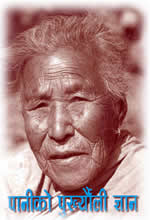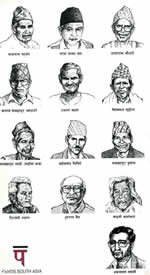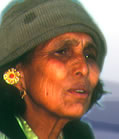 |
 |
||
 |
|||
| LOCAL THEMES agriculture communications community activities conflict development economics education employment and income environment family life festivals gender health identity justice and crime migration politics social relationships spiritual beliefs water BACKGROUND
OTHER LOCATIONS |
introducing the area The kingdom of Nepal lies along the southern Himalaya with China to the north and India to the south. This relatively small country has a remarkably varied terrain and climate.
The landscape ranges from the flat plains of the terai in the south with its tropical monsoon climate, to the continual ice and snow of the Himalaya in the north, where eight of the world's 10 tallest peaks are located, including Sagarmatha (Mount Everest). Nepal's geographic and climatic range is matched by its ethnic and linguistic diversity: Nepali is the official language but there are 20 other languages and numerous dialects. The majority of Nepalis are Hindu, with a small percentage following Buddhism, though many practise a combination of both faiths and celebrate common religious and agricultural festivals.
the themes
Interviews 19-23 were recorded in 1998, and focus especially on water resources and related issues. Both sets of narrators explain how pressure on the land means there is sometimes little choice for people but to clear the forest. However, several talk positively of their efforts, sometimes with NGO assistance, to manage and protect their forests, fields and water supplies. Some point to a significant rise in living standards as a result of efforts to control erosion and make better use of the land through terracing and pond construction. As survival from farming alone becomes increasingly difficult, people express great hope in education as the means for their children to find employment, although isolation and poverty are a major constraint on access to schooling. Education is also recognised as being empowering: enhancing the position of women; preventing people from being cheated by others; and breaking down social barriers between higher and lower castes. Indeed the testimonies suggest that the caste system, although officially declared non-existent, remains influential. Narrators describe caste differences and characteristics on a number of occasions, as well as prejudice and discriminatory practices. A couple of the new narrators, interviewed in 2002, speak with passion on the subject. Gender is another prominent theme; several narrators provide detailed accounts of women's position and experience in society. Different experiences of, and perspectives on, migration - an increasing trend - are other key topics. Two of the new narrators provide compelling first-hand accounts of migration. One tells of working in Kathmandu's carpet industry; the other is tricked into working as a prostitute in India. And while economic necessity has been the main driving force for migration, the new collection suggests that migration and displacement have greatly increased in the most conflict-ridden areas. Five of the new interviews vividly illustrate the impact of the Maoist insurgency on ordinary people, caught in the middle of the violence and seeing their hard-won development gains eroded.
the partnersPartners ActionAid have been operating in Nepal since 1982. Thirty-five testimonies were collected by AAN field staff in 1995; 19 were selected for the website. Many interviewers had some experience of participatory research, but felt that the oral testimony methodology enabled them to widen their perspective and move away from seeing village life only in terms of sectors such as health, credit and education. The OT approach provides more space for discussion about cultural and social aspects of people's lives. These may lie outside the sphere of a specific sector but nevertheless have a bearing on, for example, people's economic and environmental decisions. The five testimonies that focus specifically on water-related issues were collected as part of a separate project coordinated by Panos South Asia (PSA) in 1998. Like the other interviews they were recorded on cassette, but are available only in edited versions, with the interviewer's questions removed. These interviews were published by PSA in Nepali (Paaniko Purkhyauli Gyan) and English (Water Wisdom). In 2002, Sangeeta Lama, a journalist who had worked on Water Wisdom, gathered nine more interviews with women which touched on a number of subjects, including caste discrimination and migration, and which highlighted the impact of the Maoist insurgency. A Nepali publication drawing on all three collections was published in 2003.
publications
|
|||||||||||||
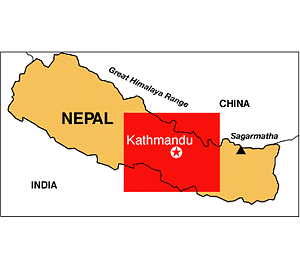
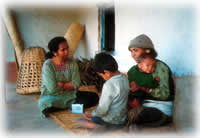 Nepal's forests and rivers have much productive potential, yet in many areas the land has been severely degraded. Increased demand as a result of population growth, together with illegal logging and clearance for agriculture, led to significant loss of tree cover. However, the government's Forest Act contributed to the successful implementation of the Community Forest Programme, which has made considerable progress in protecting the forest through the involvement and participation of local people. Indeed, many of the healthiest forests are those managed and owned by villagers who know their survival depends on them.
Nepal's forests and rivers have much productive potential, yet in many areas the land has been severely degraded. Increased demand as a result of population growth, together with illegal logging and clearance for agriculture, led to significant loss of tree cover. However, the government's Forest Act contributed to the successful implementation of the Community Forest Programme, which has made considerable progress in protecting the forest through the involvement and participation of local people. Indeed, many of the healthiest forests are those managed and owned by villagers who know their survival depends on them.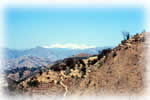 Nepal has had a turbulent political history. In 1951 the Rana regime was overthrown and replaced for a short time with a democratic system, but in 1961 the King dissolved parliament, banned political parties, took control and established a partyless
Nepal has had a turbulent political history. In 1951 the Rana regime was overthrown and replaced for a short time with a democratic system, but in 1961 the King dissolved parliament, banned political parties, took control and established a partyless 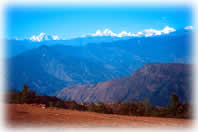 Testimonies 1-18 were collected during 1995. Some narrators were from Nawalparasi and Sindhuli districts, but the majority from the western part of Sindhulpalchok, a district north of Kathmandu characterised by steep, terraced and often eroded hillsides ranging from 700 to 2000 metres. Being close to Kathmandu may have its benefits but it has some disadvantages: most of the Nepali girls who end up in India as prostitutes come from Sindhulpalchok. The amount families make from the "middlemen" is often three times the average yearly income. For many, there are few other economic options and the struggle to make ends meet is evident in many of the testimonies. Indebtedness to moneylenders appears to be a widespread problem; many households cannot survive on their own produce throughout the year and have to borrow to bridge the gaps. The increasing cost of living is a key concern. In addition to goods, festivals and weddings are becoming more expensive and lead many into debt.
Testimonies 1-18 were collected during 1995. Some narrators were from Nawalparasi and Sindhuli districts, but the majority from the western part of Sindhulpalchok, a district north of Kathmandu characterised by steep, terraced and often eroded hillsides ranging from 700 to 2000 metres. Being close to Kathmandu may have its benefits but it has some disadvantages: most of the Nepali girls who end up in India as prostitutes come from Sindhulpalchok. The amount families make from the "middlemen" is often three times the average yearly income. For many, there are few other economic options and the struggle to make ends meet is evident in many of the testimonies. Indebtedness to moneylenders appears to be a widespread problem; many households cannot survive on their own produce throughout the year and have to borrow to bridge the gaps. The increasing cost of living is a key concern. In addition to goods, festivals and weddings are becoming more expensive and lead many into debt.